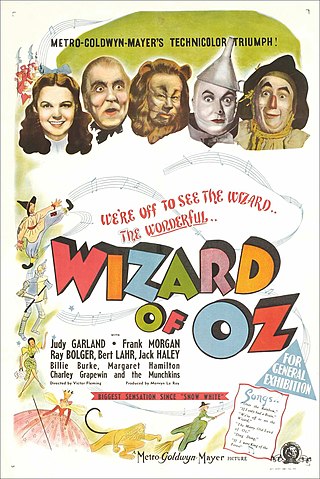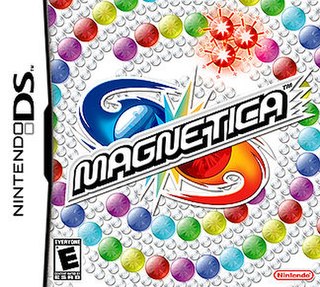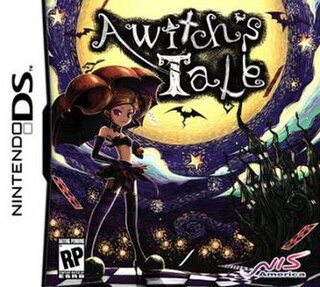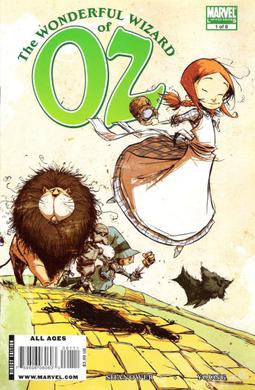
The Wonderful Wizard of Oz is a 1900 children's novel written by author L. Frank Baum and illustrated by W. W. Denslow. It is the first novel in the Oz series of books. A Kansas farm girl named Dorothy ends up in the magical Land of Oz after she and her pet dog Toto are swept away from their home by a cyclone. Upon her arrival in the magical world of Oz, she learns she cannot return home until she has destroyed the Wicked Witch of the West.

Oscar Zoroaster Phadrig Isaac Norman Henkle Emmannuel Ambroise Diggs is a fictional character in the Land of Oz created by American author L. Frank Baum. The character was further popularized by a stage play and several films, including the classic 1939 film and the 2013 prequel adaptation.

A Munchkin is a native of the fictional Munchkin Country in the Oz books by American author L. Frank Baum. They first appear in the classic children's novel The Wonderful Wizard of Oz (1900) where they welcome Dorothy Gale to their city in Oz. The Munchkins are described as being the same height as Dorothy and they wear only shades of blue clothing, as blue is the Munchkins' favorite color. Blue is also the predominating color that officially represents the eastern quadrant in the Land of Oz. The Munchkins have appeared in various media, including the 1939 film The Wizard of Oz, as well as in various other films and comedy acts.

The Wizard of Oz is a 1939 American musical fantasy film produced by Metro-Goldwyn-Mayer (MGM). An adaptation of L. Frank Baum's 1900 children's fantasy novel The Wonderful Wizard of Oz, it was primarily directed by Victor Fleming, who left production to take over the troubled Gone with the Wind. It stars Judy Garland, Frank Morgan, Ray Bolger, Bert Lahr, Jack Haley, Billie Burke and Margaret Hamilton. Noel Langley, Florence Ryerson and Edgar Allan Woolf received credit for the screenplay, while others made uncredited contributions. The music was composed by Harold Arlen and adapted by Herbert Stothart, with lyrics by Edgar "Yip" Harburg.

Diddy Kong Racing is a 1997 racing video game developed and published by Rare for the Nintendo 64. The game is set on Timber's Island and revolves around Diddy Kong and his friends' attempt to defeat the intergalactic antagonist, a wizarding pig named Wizpig, through winning a series of races. The player can take control of any of the featured characters throughout the game. Diddy Kong Racing features five worlds with four racetracks each, and the ability to drive a car, hovercraft, or pilot an aeroplane. Timber Island is loosely based on the geographical landscapes of the United States.

Pokémon is a series of video games developed by Game Freak and published by Nintendo and The Pokémon Company under the Pokémon media franchise. It was created by Satoshi Tajiri with assistance from Ken Sugimori, the first games, Pocket Monsters Red and Green, were released in 1996 in Japan for the Game Boy, later released outside of Japan as Pokémon Red Version and Blue Version. The main series of role-playing video games (RPGs), referred as the "core series" by their developers, has continued on each generation of Nintendo's handhelds. The most recently released core series games, Pokémon Scarlet and Violet, were released on November 18, 2022, for the Nintendo Switch.

Meteos is a 2005 tile-matching video game developed by Q Entertainment and published by Bandai for the Nintendo DS. It was produced by Q Entertainment founder Tetsuya Mizuguchi and designed by Masahiro Sakurai. Meteos was inspired by the video game Missile Command (1980), the film The Matrix (1999) and the television series 24 (2001-2010).

Magnetica is a puzzle video game for the Nintendo DS, released as part of the Touch! Generations series. The game was developed by Mitchell Corporation and published by Nintendo, and is based on Mitchell's 1998 arcade game Puzz Loop.

Harvest Moon DS: Island of Happiness, known simply as Harvest Moon: Island of Happiness, and known in Japan as Bokujō Monogatari: Kimi to Sodatsu Shima, is a farm simulation video game published and developed by Marvelous Interactive Inc. in Japan, and released in North America by Natsume Inc. exclusively for the Nintendo DS. It is the third installment of the Story of Seasons series on the DS. It is the first entry without series creator Yasuhiro Wada involved.
Rune Factory is a franchise of fantasy role-playing simulation games created by Yoshifumi Hashimoto and primarily published by Marvelous. The games are developed by Hashimoto's studio Hakama, taking over from Neverland after they ceased operations in 2013. The series began as a spin-off to Marvelous' flagship franchise Story of Seasons. The Story of Seasons references were subsequently dropped starting with the second installment, in order to become its own series. With the first game published in 2006, the property consists of five main-series games, two spin-off titles and numerous manga adaptations.

The Wonderful Wizard of Oz is a 1900 children's novel written by American author L. Frank Baum. Since its first publication in 1900, it has been adapted many times by L. Frank Baum and others: for film, television, theatre, books, comics, games, and other media.

The Sims 2: Castaway is the third console spin-off of the life simulation video game The Sims 2 for the Wii, Nintendo DS (NDS), PlayStation 2 (PS2) and PlayStation Portable (PSP). It is also available on mobile phones; Nokia offered Castaway on the Ovi Store. A roughly similar game, The Sims Castaway Stories, is available for personal computers, but is not a direct port of Castaway.

A Witch's Tale is a 2009 video game for the Nintendo DS. It was developed by Hit Maker and published by Nippon Ichi Software.

The Wizard of Oz is a musical with a book by John Kane, music by Harold Arlen and lyrics by E. Y. Harburg. It has additional background music by Herbert Stothart. It is based on the 1900 novel The Wonderful Wizard of Oz by L. Frank Baum and the 1939 film version written by Noel Langley, Florence Ryerson and Edgar Allan Woolf.

Space Bust-A-Move is a puzzle video game developed by Lancarse and published by Taito in Japan, and Square Enix worldwide for the Nintendo DS. It was first released in Japan under the title Space Puzzle Bobble on December 18, 2008. It was later released in North America under the title Space Bust-A-Move on July 28, 2009, and in Europe under the title Puzzle Bobble Galaxy on August 28, 2009. As with Arkanoid DS, Space Invaders Extreme and Space Invaders Extreme 2, the game is compatible with Taito's paddle controller.

The Wonderful Wizard of Oz (2009) is an eight-issue comic book limited series adapting the L. Frank Baum novel of the same name. The series was written by Eric Shanower with art by Skottie Young and published by Marvel Comics.

The Wizard of Oz is a 2011 musical based on the 1939 film of the same name in turn based on L. Frank Baum's novel The Wonderful Wizard of Oz, with a book adapted by Andrew Lloyd Webber and Jeremy Sams. The musical uses the Harold Arlen and E. Y. Harburg songs from the film and includes some new songs and additional music by Lloyd Webber and additional lyrics by Tim Rice. It is the third stage musical adaptation of the film following the 1942 version for the St. Louis Municipal Opera and the 1987 version for the Royal Shakespeare Company.

Ni no Kuni: Wrath of the White Witch is an action role-playing game, developed by Level-5. The game is a significantly enhanced version of Ni no Kuni: Dominion of the Dark Djinn, which originally released for the Nintendo DS in Japan in December 2010. It was released for the PlayStation 3 in Japan in November 2011, and published in Western regions by Namco Bandai Games in January 2013. It was also released for Nintendo Switch in September 2019. A remastered version was released for PlayStation 4 and Windows in September 2019, and for Xbox One and Xbox Series X/S in September 2022.

Ni no Kuni: Dominion of the Dark Djinn is a role-playing video game developed and published by Level-5. It was released in Japan for the Nintendo DS on December 9, 2010. Players control Oliver, a young boy who sets out on a journey to save his mother. The game is played from a third-person perspective and its world is navigated on foot or by boat. While players navigate Oliver throughout the game's world, other characters can be controlled during battles against enemies; during these battles, players use magic abilities and creatures known as "imajinn", which can be captured and tamed.



















